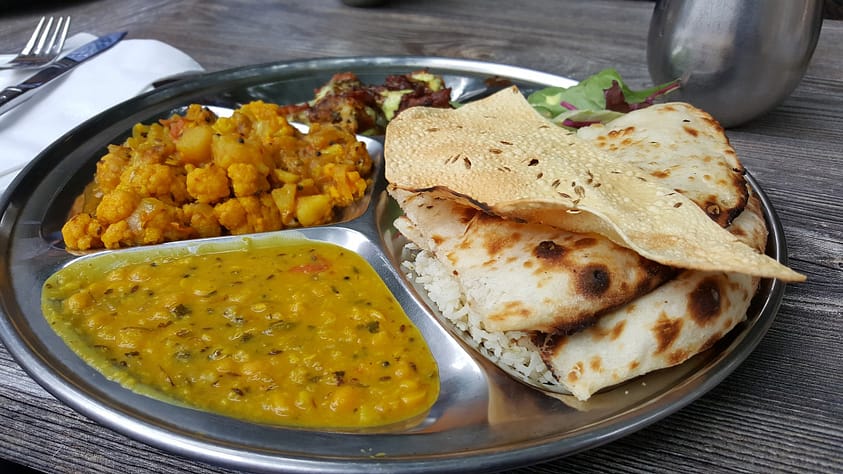Indians, and South Asians in general, tend to have a high risk of heart disease and diabetes. This is due to genetic factors, sedentary lifestyles and a high carbohydrate diet. High carbs contribute to excess body fat and chronic health conditions.
Those of us used to a particular diet would not feel comfortable changing to something quite different, but it is possible to make our diet more healthy.
A typical meal in the Indian diet often consists of a potato ‘vegetable’ dish along with a bread such as puri or paratha. These dishes are high in carbohydrates and fats. Here are a few suggestions on how to eat a healthy South Asian diet.
Table of Contents
Carbohydrates in the Healthy Indian diet

- Limit the consumption of refined carbohydrates and potatoes. All purpose flour or maida, being refined, contributes to spikes in blood sugar. Use whole wheat flour or atta instead, maybe with chickpea flour or besan. Consume brown rice instead of white rice.
- Consume unrefined whole grains such as brown rice, cracked wheat or daliya, barley, millet, quinoa and amaranth. These have more fiber and are consequently more filling.
- Make your carbohydrate dish such as rice, chapati or potatoes no more than ¼ of your plate.
- Limit consumption of fried foods such as puri, paratha, and kachori. Have these as a treat in limited quantities and occasionally.
- Limit consumption of sweets or mithai. Many of us are used to ending a
meal with a sweet. Again, have these as a treat, occasionally and in
limited quantities. - Have fruit as dessert.
- Use healthy sugar substitutes like stevia.
- Limit consumption of sweet beverages such as juice, soft drinks, sweetened lassi, etc.
- Consume more fermented foods such as yogurt, buttermilk or mattha, and pickled vegetables.
- Eat more non-starch vegetables, such as cauliflower, broccoli, eggplant, cabbage, okra, carrots, etc.
- Make sure you are drinking enough water. Check out my post on Hydration for recommendations on how much water to drink.

Fats in the Healthy Indian diet
- Consume foods low in saturated and trans fats such as ghee, butter, cream, vanaspati and palm oil.
- Avoid too many foods with added salt, sugar and fats such as store bought cookies or biscuits, cakes, and pastries.
Proteins in the Healthy Indian diet
- When consuming meat dishes, opt for fish and chicken, preferably prepared with healthy oils in a tandoor, rather than fried.
- Consume more fermented foods such as yogurt, buttermilk or mattha and pickled vegetables.
- Have more plant based proteins, such as tofu instead of paneer, lentils or dal and legumes/beans.

Snacks in the Healthy Indian diet
Snacks can be the bane of our diet. Following the guidelines listed above, some good choices include:
- Nuts
- Fruit
- Dried Fruit
- Makhana
- Bean Sprouts (can be shallow fried with a few drops of oil, or oil spray
- Kala Chana or Chhole
Indian food can be healthy by following the above mentioned guidelines. As Indians, we pride ourselves on making wholesome meals from scratch. A few tweaks will get us there.
Sources:
sutterhealth.org
fraserhealth.ca
lipid.org
No content on this site, regardless of date, should ever be used as a substitute for direct medical advice from your doctor or other qualified clinician.




